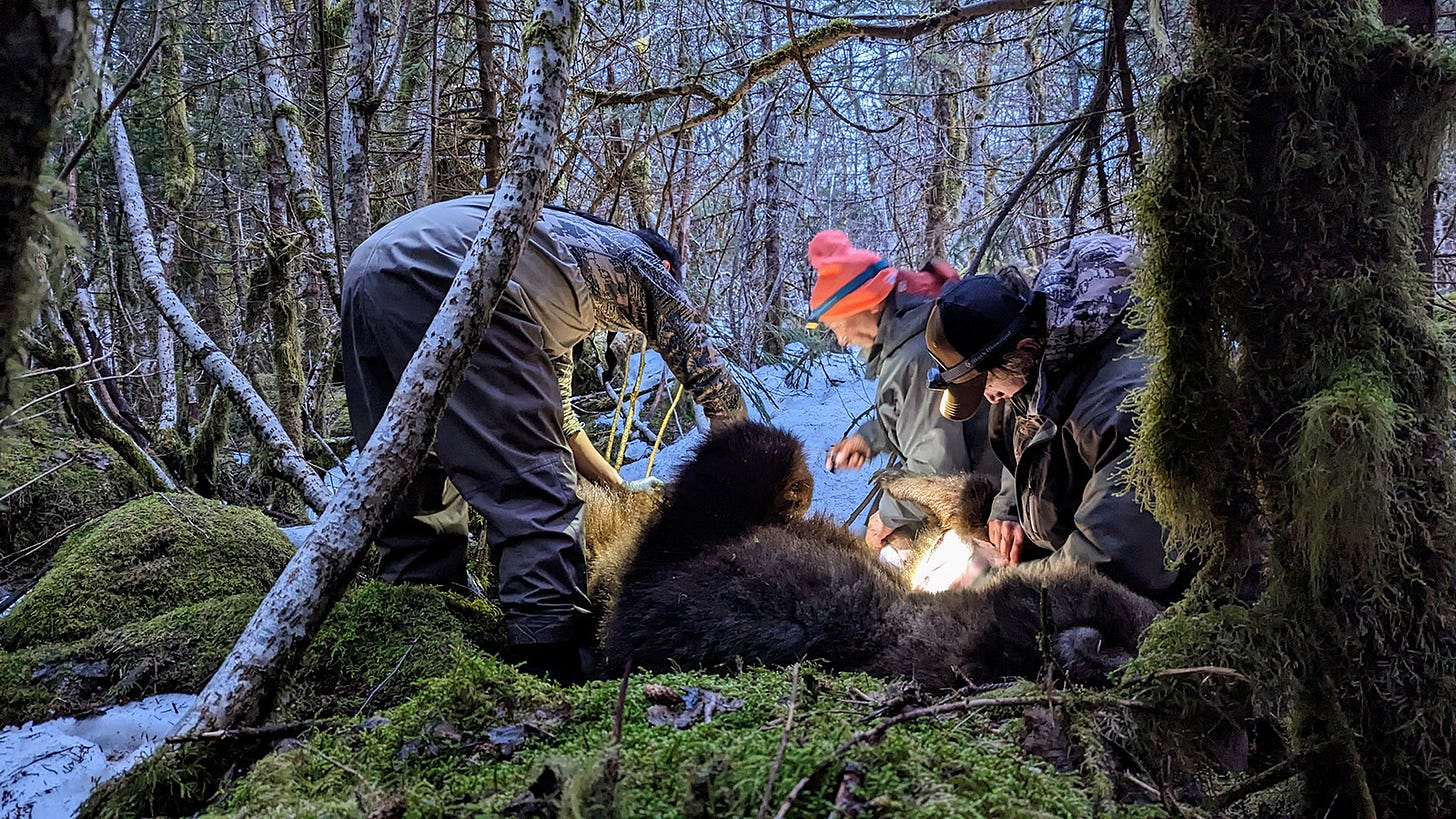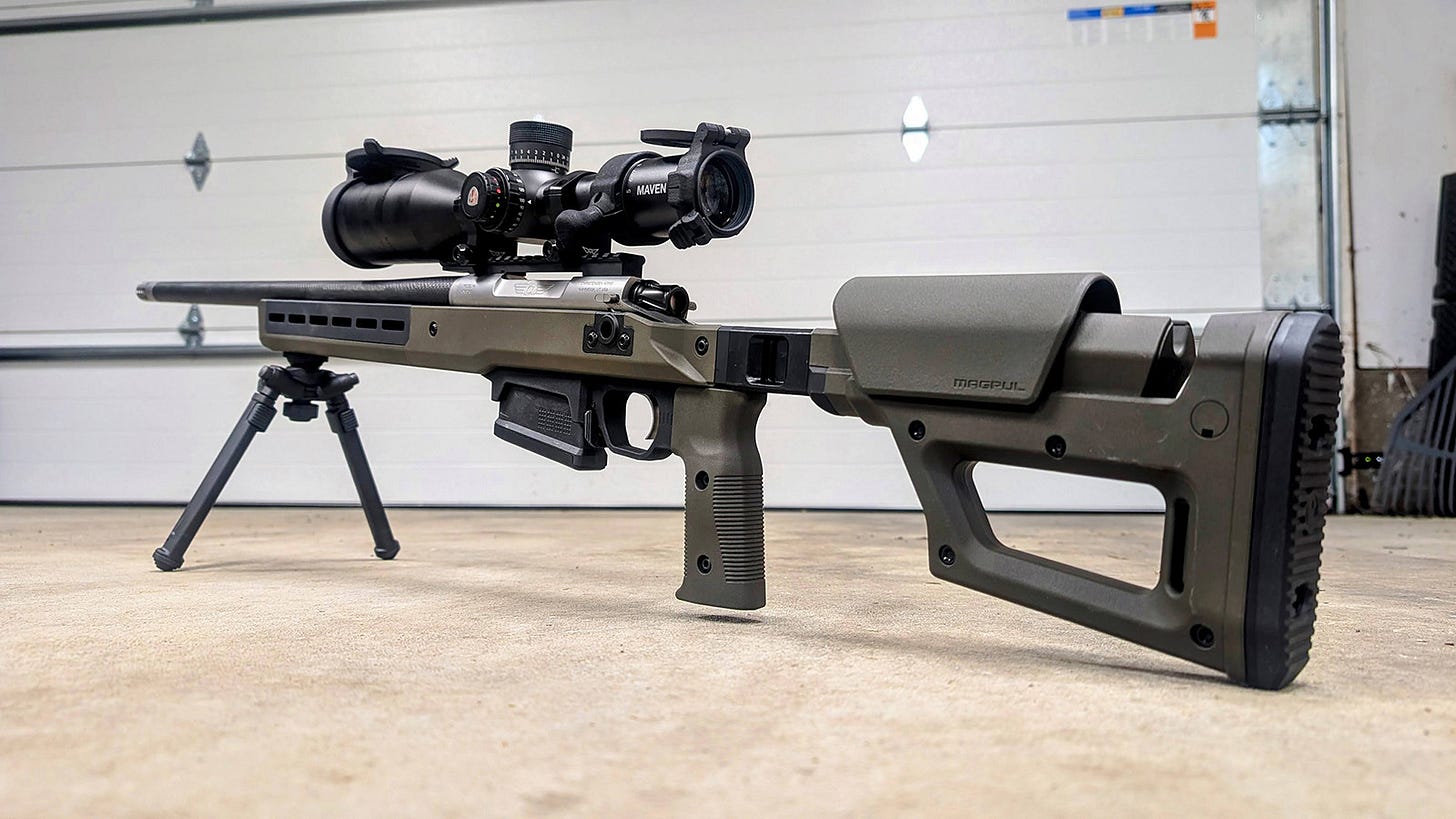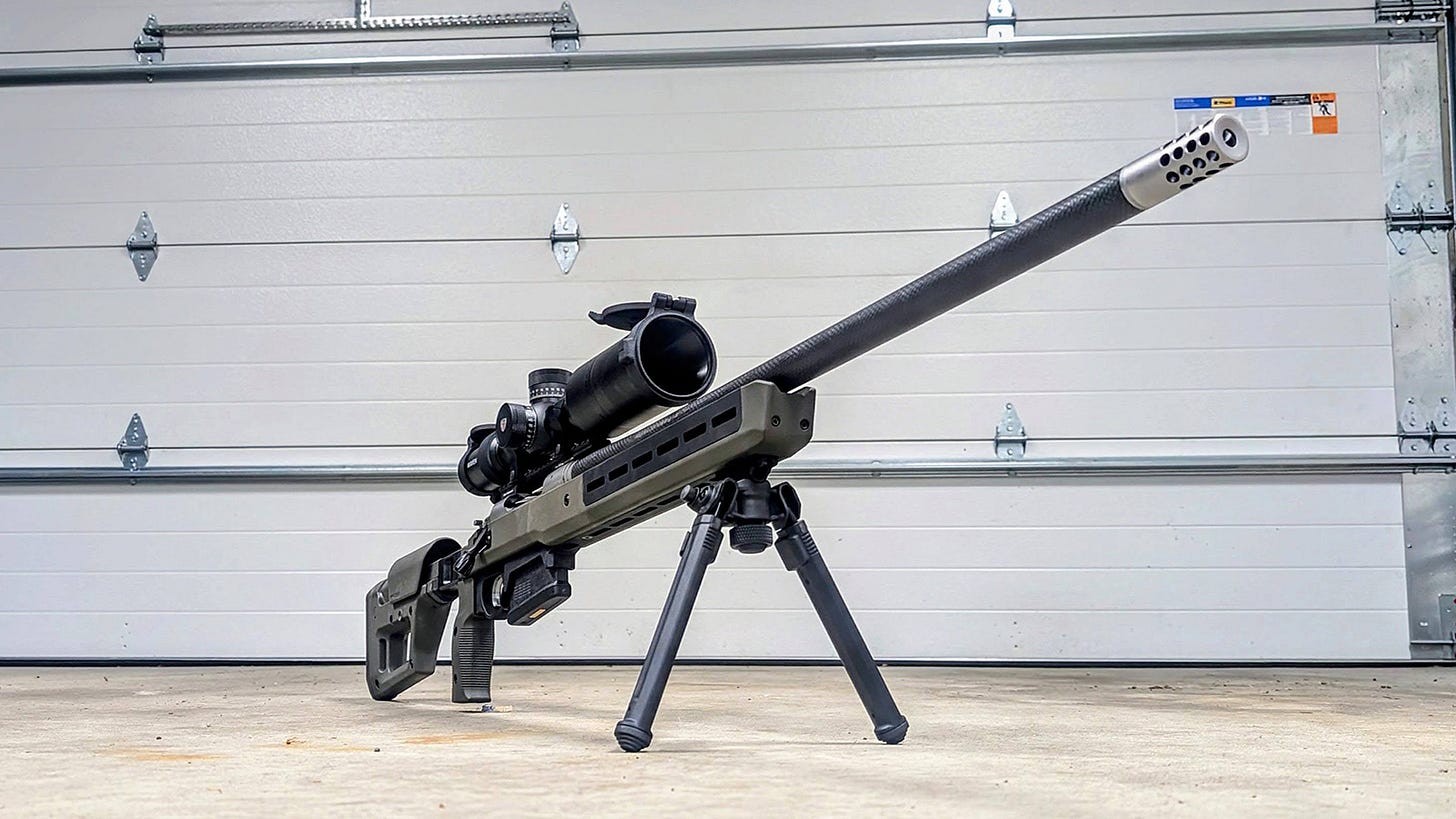What I Learned About Guns From A Man Who Kills Brown Bears For A Living
An argument for heavy rifles and big glass, even at moderate ranges
A year-and-a-half ago Virginia and I went on an Alaska Peninsula brown bear hunt with an outfitter who calls himself “The Grizzinator.” Greg’s outfitted brown bear hunts for over 30 years, and has likely shot, or participated in the deaths of more of the big bears than anyone else out there. So aside from proving a great opportunity to spend a couple of weeks listening to Gregorian chants, it was also a fascinating chance to learn about the practical application of firearms in challenging environments and potentially deadly circumstances.
When it comes to firearms, I am very much not an expert. If you are looking for that kind of advice, I recommend friends like John Snow, Tyler Freel, and Andrew McKean over at Outdoor Life. What I am is an average enthusiast who enjoys both recreational shooting and hunting, and who carries firearms for legitimate self defense needs involving both two- and four-legged predators, often in more dangerous circumstances than most other civilians. As I continue to learn more about the practical application of guns in real world situations, it’s my hope that you can benefit from the experience of someone like you.
With Rifles, Weight Is Your Friend
Like most other mountain hunters, I’ve spent the last decade chasing lighter and lighter weights, both for stuff I carry in my backpack, and on the weapon itself. So I thought my 6.7-pound, carbon-barreled, .300 Winchester Magnum Christensen Ridgeline was the bee’s knees…until I tried to shoot it away from a bench rest.
While I had no trouble grouping the thing under half an inch at 100 yards with the aid of heavy front and rear shooting bags at an indoor range, real world circumstances proved more elusive. Set up on my 4.8 ounce Spartan Precision Javelin Lite bipod, I struggled to achieve two-inch groups, even with the aid of a concrete table at an outdoor gun range. And that was with a 24.5 ounce, 2.5-15x44 Maven RS.1 on top.
Probably fortunately, that rifle fell apart before I had a chance to actually point it at an bear in Alaska. When I pulled it out of the case on Greg’s boat, the safety selector was jammed on safe. Disassembly revealed a trigger tension pin that was under no friction from the factory (and also a pile of whitetail blood from last year, oops), and had walked out of its housing. We repaired it with red Loctite. Next, after we’d stalked a giant bear into 30 yards, the magazine follower snapped in half when I tried to chamber a round, jamming the gun. The bear winded us, and charged past me at about 5 yards. It was really fun holding a non-functioning firearm in that moment.
“My opinion of Christensen is that they look at whatever’s cool in the moment, then try to replicate it as cheaply as possible,” the Grizzinator told me, while we were examining the rifle back on the boat.
“I’ve spent 35 years watching clients miss shots,” Greg continued. “And every time they do, I ask myself why. I’ve come to the conclusion that it’s the rifle’s fault. Trigger punches are going to happen. Flinches happen. It’s natural to get nervous when you’re that close to a bear. So if I can build a rifle that allows you to make the shot anyways, why wouldn’t I?”
Greg says most of his return clients simply choose to shoot his rifles from their second hunt with him on. That eliminates the need for them to transport a fragile firearm, and allows them to shoot the most accurate, stable platforms possible.
And that’s what I ended up shooting. After dry firing the trigger once, I felt confident enough with one of Greg’s custom .300 WinMags to carry it on a bear stalk. And the first time I pulled that trigger in anger, I put a 200 grain Hornady A-tip through both lungs and the heart of bear from 220 yards away, while perched on a wet, slimy rock, with frigid waves breaking over my feet.
A big reason why I was able to perfectly execute a shot on an unfamiliar rifle was its weight. Built on an aluminum chassis, with a heavy profile, 26-inch steel barrel, and equipped with a 30-power scope, it probably weighed at least 18 pounds or so. I can’t remember if Greg had added additional weights in the slots on the forend, but it was heavy enough already. Even cold, even excited, even under pressure, the thing was just rock solid.
“The reason why we’re here is to kill a bear, not carry a rifle,” Greg told me later. “Suck it up, you can handle the weight.”
All The Glass, All The Time
Also in pursuit of light weights, forgiving eyeboxes, and affordable prices, I’ve never run a scope with greater than 15-power on a rifle before. I usually opt for 9 to 12x. That Maven RS.1’s 44mm objective is also as big as I’ve ever put on one of my own guns.
But Greg has a different approach. All of his primary hunting rifles (obviously his guide guns are setup differently) feature scopes with magnifications of at least 30x, and all feature very large objectives.
If you’re going to be hauling around a heavy rifle already, why not equip yourself with the ability to see your targets with as much detail and precision as possible?
Also, none of those scopes is super high end. While Swarovski glass may be the finest on the planet, equipping multiple guns with it would prove a massive financial burden. And there’s more effective things a scope can do than offer crystal-clear clarity.
It’s the job of a large objective lens to bring as much light into the optic as possible. This is not the same thing as low-light performance, which is more about prism design and glass coatings. What that light transmission on big objectives does is transmit better color clarity and resolution.
All that top-end magnification also means that, turned up part of the way, those scopes still deliver generous eye relief, even at magnification levels exceeding those of smaller units. So while I was used to squinting through a tiny hole at full power on that 15x RS.1, the 30x scope on the rifle I shot forgave a varied head position and delivered a wide field of view when I set it at 18x to shoot that bear. And all of that just saved time, reduced stress, and created one less thing to worry about during such a high pressure moment.
A major exception there was with binoculars. Of the three hunters and five guides on the boat, no one was using anything other than Swarovski binoculars and spotting scopes. While that brand may not offer very large objective, very high magnification scopes, its ability to manufacture the finest quality glass on the planet is still very much relevant when it comes to finding animals in the first place.
A big makeover for the Ridgeline. I dig the dead-simple nature of the Magpul Pro 700 Lite stock, and its set-with-tools adjustments.
Don’t Bring Your Elephant Gun
Before the hunt, Virginia’s dad gave me a few guns from his collection, ranging in calibers from .338 WinMag, to .375 Ruger. I had never seen a peninsula brown bear before, much less taken aim at one, so wanted to make sure I was bringing the right weapon, and called Greg to clarify.
He actually recommends nothing heavier than .300 WinMag, even for the biggest brown bears on earth.
“Accurate shots are much more important than caliber,” he told me. “Bring something you know you can shoot.”
My friend Justin Moore, who reps Nosler, has explained in the past that it’s bullet construction—the ability to hold together while properly expanding—that determines lethal performance, not outright power.
The proof is in the pudding. With a 200 grain aluminum tipped, copper jacketed bullet through both of its lungs and heart, the bear lived maybe 30 seconds after being shot with a single round. Brown bears are the largest land predators in North America. .300 Win Mag will take anything on this continent, do so decisively, and deliver far less recoil in the process than many supposedly more capable calibers.
With Handguns, Nothing Is Ever Certain
A big part of Greg and his guides’ jobs is tracking wounded bears through dense brush, to bring clients the result they’ve paid for, even after bad shots.
So while they’re carrying a variety of custom large-caliber semi-auto and lever action rifles as their primary bear-dispatch mechanism in those circumstances, they’re still relying on handguns for backup, should shit go south. Greg says he’s had that happen more times then he could count, and that there’s no sure solution in situations that fail to handgun level.
He carries a Glock 21 converted to fire .460 Rowland, the most powerful round it’s possible to reliably run through a semi-automatic handgun. He alternates Lehigh Defense penetrators and hollow points in his magazines, and says he just tries to get as many rounds as possible into the animals in the shortest time. Sometimes the hollow points stop right under the skin, and sometimes they do the job. Sometimes the penetrators go all the way through without hitting anything important.
My bear dropped inside some willows, where we couldn’t see it. I’d been hunting with Greg’s youngest guide, who’d left his backup rifle on the skiff when we climbed out of the boat to shoot, in order to save time. And while I appreciated Brian’s confidence in my abilities, Greg did not. We pulled back to the main boat, which was an hour away, to regroup, and give the bear time to die. Things were visibly tense as a former Navy SEAL, his dad, Brian and Greg tooled up for a potentially life threatening encounter with the bear, should he still be alive. I insisted on being there, but left Virginia behind for safety. It was about as serious of a circumstance as I’ve been in, until we peaked into the willows, and the bear was laying right there, fully expired. Phew. We all safed our firearms and set about processing.
Getting behind it feels like a whole new gun. One with new ergonomics and shooter requirements. And one I’ve yet to master.
How I’ve Applied This Knowledge To General Hunting
I thought about building a fully custom rifle on Greg’s model, but with a $2,000 rifle sitting worthless in our wine cellar/armory, figured maybe I should just use it instead. Despite cheap furniture and accessories, Christensen does make a good action and barrel.
So, I ordered a Magpul Pro 700 Lite long action chassis to house those, plus a TriggerTech Diamond in. That fundamentally alters not only the platform’s stiffness and adjustability, but also adds about four pounds of weight to the rifle itself. Versus a folding option, the 700 Lite is not only much more affordable ($600), but also simpler, with no real potential for malfunction. To that I affixed an 11 ounce Magpul Bipod.
I also swapped out the Maven RS.1 for a 35 ounce, 5-30x56 Maven RS.4. That same scope is white labeled at a Japanese factory by other brands including Leica, but at $1,800 is here $700 more affordable.
The end result weighs about 12.5 pounds, feels considerably more robust, and feeds from box magazines rather than a hinged floor plate. I’ve kept the carbon barrel for now, but may either swap it for a heavy profile steel item in the future, or just leave it as is and build something even heavier duty in .300 PRC.
How’s it shoot? Well, I’m still getting used to it. On the bipod, I’m easily managing one-inch groups. On bags, I’m not getting better results than I was able to achieve without all the fancy stuff. At least at 100 yards, which is the furthest I’ve shot it so far. (I took rifle season off this year to focus on a sick dog, and did not shoot much in preparation either.) The vertical grip and big stock are taking some getting used to, as is all the adjustment available on the new scope.
And that’s ok. Aside from dicking around with friends, I have no plans to shoot this rifle any further than the self-imposed 600-yard limit I apply to any animal. I’m out there to hunt, not kill, enjoy stalking more than shooting, and don’t want to deal with variables that make wounding something more than a slim likelihood (it’s always there). But, within that same distance, I think this setup will deliver considerably more stability, and much more surety than I was achieving before. With more practice, I’ll feel much more confident when I do get a chance to pull a trigger, which is the entire point. But yeah, it’s a bitch to carry.






“A big part of Greg and his guides’ jobs is tracking wounded bears through dense brush, to bring clients the result they’ve paid for, even after bad shots.”
Not to mention doing the right thing for the animal.
A third of a mile shooting limit? Definitely doesn't seem restictive